|
American Civil War Photographs and Pictures
Western North Carolina and the Thomas Legion
(Additional American
Civil War Pictures and Photos located at the bottom of this page. Each photograph or picture, furthermore, includes
description and attribution)
If you possess
additional information about the veterans in these photographs, please contact us. And if you retain or own related pictures
and desire to post them on www.thomaslegion.net, please contact Matthew Parker at: americancivilwar [@] yahoo.com
Cherokee Chief, Confederate Colonel, Lawyer, Entrepreneur, and Politician
February 5, 1805--May 10, 1893
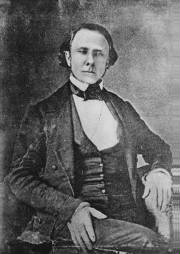
Photograph is Courtesy of the North Carolina Office of Archives and History
1858 photograph of 53 year old Senator (Chief) William
Holland Thomas.
William Holland Thomas Historical Marker
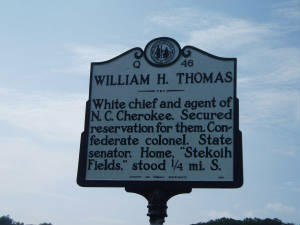
Photograph
is Courtesy of the North Carolina Office of Archives & History: Department of Cultural Resources
Photos Thomas'
Legion of Cherokee Indians and Highlanders
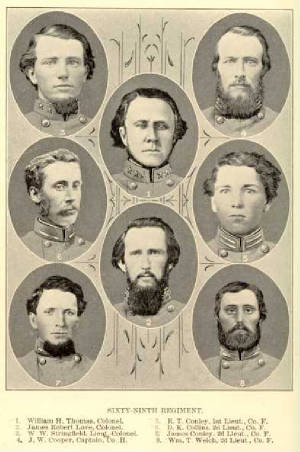
Picture is Courtesy of the North Carolina Division of Archives and History
Photos 5 thru 8 are officers from Company F or "Conley's Sharpshooters."
When General Jubal Early aborted the campaign to sack Washington, Union cavalry approached the rear of the Confederate army. "Old Jube" ordered sharpshooters from Thomas' Legion to engage
the cavalry. Lt. Robert T. Conley and twenty-five marksmen from Company "F" of Love's Regiment were instrumental in forcing the enemy across
the river. General Gabriel C. Wharton wrote to James R. Love, December 8, 1864, and complimented Lt. Conley and Thomas' Legion for their "coolness and bravery in the
fight." Company F was in the thick of the fight during the Battle of Piedmont, Virginia, and it lost several good men, including Lt. James Conley, number 7 in above photograph.
Adams Brothers of the Thomas Legion
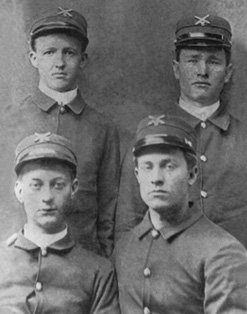
Photograph is Courtesy of grahamcounty.net
Adams Brothers: Alfred and Benjamin, top; Aseph and John Posey,
bottom. They all served under the command of Captain Willis Parker, Company I, Thomas' Legion.
Photographed by the Writer (February 2007)
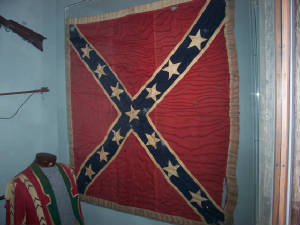
Courtesy of the Museum of the Cherokee
Indian
The Thomas Legion Historical Marker
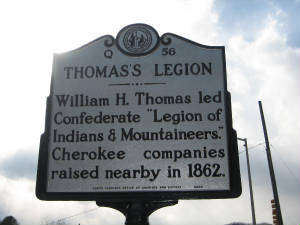
Photo is Courtesy North Carolina Office of Archives & History: Department of Cultural Resources
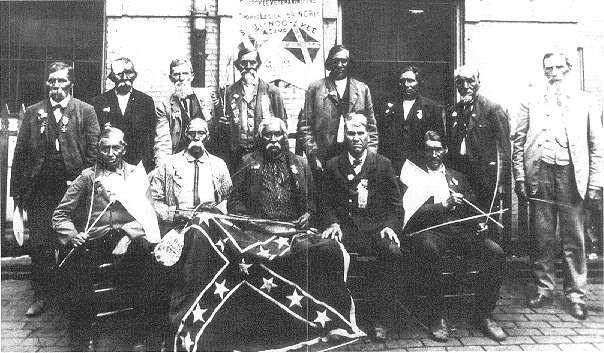
Photograph is Courtesy of the Waynesville Mountaineer Photos
The Cherokee veterans posed for their last photograph
at New Orleans Confederate Reunion in 1903. Banner Inscription: “Cherokee Veteran Indians
of Thomas’ Legion, 69 N.C. Regiment, Suo-Noo-Kee Camp U.C.V.
4th Brigade, N.C. Division”
Pictured from left to right; Front row: Usai, Kimson Saunooke, Jesse Ross, Jesse Reed, Sevier Skitty. Back row: Bird
Saconita, Dave Owl, Lt. Colonel William Williams Stringfield, Lt. Suatie (Suyeta) Owl (Owle), Jim Cag, Wesley Crow, Jessan, Lt. Calvin Cagle. (Cagle is often reported as a member of
the Legion, but no records confirm it. However, his presence appears to connect him to the Legion). Names were furnished
by the late James R. Thomas, son of William H. Thomas. It is the editor's view that this is the most accurate "photograph
interpretation" available.
Confederate Veterans of Haywood County, N.C.
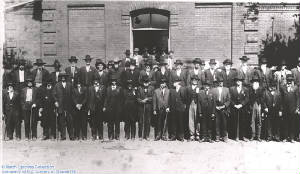
Reunion of Confederate
veterans in front of Franklin’s Courthouse (ca. 1905).
Confederate Soldiers
Monument, Front Lawn, Yancey County Court House, 110 Town Square, Burnsville, N.C.
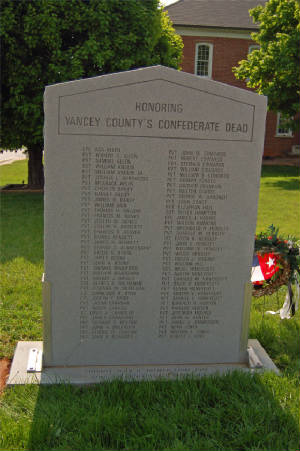
Courtesy
of Michael C. Hardy at michaelchardy.blogspot.com
Confederate Veterans of Transylvania County, N.C.
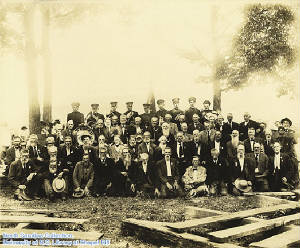
Reunion
of Confederate veterans: believed to be at Brevard, N.C., 1911.
Confederate Veterans of Jackson County, N.C.
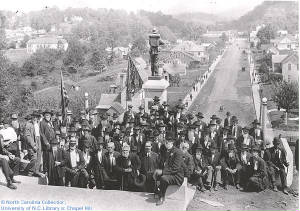
Sylva, Jackson County, NC: The unveiling of the Confederate Monument at Sylva on September 18,
1915; more than 3,000 people were in attendance. "In the mid-1990s the statue was removed, refurbished and rededicated,"
according to The Sylva Herald in Jackson County.
Confederate Veterans' Memorial of Jackson County, N.C.
Photographed by the Editor
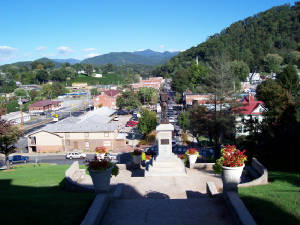
Sylva, Jackson County, NC: The Confederate Monument at Sylva in Sept. 2006.
Newspaper announcement of the Confederate
Monument unveiling in Sylva, Jackson County
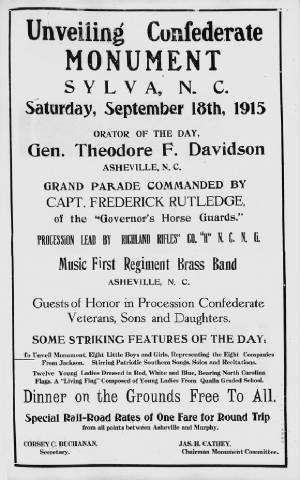
Jackson County Journal,
September 10, 1915
Recommended
Reading: Remembering North Carolina's Confederates (NC) (Images of America). Description: The
American Civil War was scarcely over when a group of ladies met in Raleigh
and began to plan commemoration for the honored Confederate dead of North Carolina. In 1867, they held their first memorial service.
Two years later in Fayetteville,
the first monument to the state's fallen Confederate soldiers was erected. Over the next 14 decades, countless monuments were
commissioned in cemeteries and courthouse squares across the state. Continued below…
Following Reconstruction,
the veterans themselves began to gather in their local communities, and state and national reunions were held. For many of
the Confederate veterans, honor for their previous service continued long after their deaths: accounts of their sacrifice
were often chiseled on their grave markers. The numerous images within this book, photographs of veterans and reunions, monuments,
and tombstones are but a sampling of the many ways that the old Confederate soldiers are commemorated across the Old North State.
About the Author: Historian and photographer Michael C. Hardy is truly one-of-a-kind; he has dedicated and sacrificed his
life preserving North Carolina’s
Civil War history and heritage. With unmatched zeal and enthusiasm, Michael travels thousands of miles annually, while crisscrossing
North Carolina, teaching, educating, speaking, listening,
researching, and reading every conceivable aspect of the Civil War as it relates to the Old North State.
Michael C. Hardy is the author of numerous books and articles about North Carolina's role during the Civil War. This is his second book
for Arcadia Publishing. A popular speaker for history associations, preservation groups, and museums, he lives with his wife,
Elizabeth, and son, Nathaniel, in the mountains of Western North Carolina.
Reunion of Bryson City Confederate Veterans
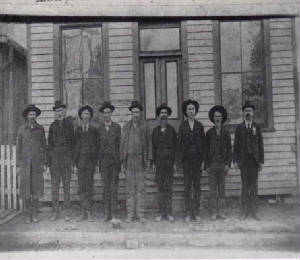
A Reunion of Civil War Veterans from Bryson City.
The 1st North Carolina Cavalry Regiment engaged in numerous fierce
battles and skirmishes, including the Battle of Gettysburg. If you possess additional information about the veterans in this photograph
please contact me: thomas_legion@yahoo.com
*Notes for Veteran Noah G.
Earls are courtesy Mr. Edward J. Earls: The soldier 4th from the right with the beard and hat is Noah G. Earls who died in
1908 (He is standing next to his brother-in-law, Sam B. Gibson, who is positioned 5th from the right). He initially served
in Company E, 39th North Carolina Infantry Regiment and was wounded at Chickamauga. He enlisted
in the Thomas legion in 1864. In May 1865, as a member of “William Stringfield's select command” and en route
to Knoxville to confirm
the Confederate surrender, he was arrested at Knoxville, Tennessee, and subsequently imprisoned in Louisville, Kentucky.
Noah G. Earls signed a second oath of allegiance at Franklin, N.C., in September 1865. Noah Grayson Earls was my grandfather. (Courtesy of Mr.
Edward J. Earls)
Editor's Notes:
On April 25, 1865, General Martin had sent written orders to Lt. Col. Stringfield and ordered him to advance to Knoxville, with a flag-of-truce, and present General George Stoneman with the “Western
District of North Carolina's surrender terms.”
Battle
of Limestone Station, Tennessee: Historical Marker
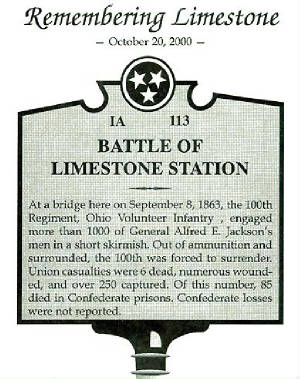
William Stringfield recorded Thomas' Legion in the battle: "[W]e forced them to surrender with [their] loss of 20 killed,
30 wounded and 314 prisoners, with 400 splendid small arms. Our loss was six killed and fifteen wounded..." (Major Stringfield
also received the sword from surrendering Union army Lt. Colonel Edwin L. Hayes). Dyer's Compendium states
the Confederates captured 240 men from the 100th Ohio Infantry Regiment. Lieutenant Colonel Milton A. Haynes records
the battle: O.R., i, 30, ii, 643 and O.R., i, 30, ii, 644. Union report: O.R., i, 30, ii, 578. Also see Histories
of the Several Regiments and Battalions from North Carolina in the Great War 1861-1865, Volume 3, p. 739, by Walter
Clark.
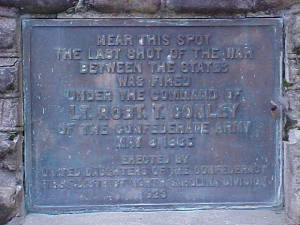
On May 6, 1865, Lieutenant Robert T. Conley and a small company from Thomas' Legion clashed with Union Lt. Col. William C. Bartlett's 2nd North Carolina Mounted
Infantry Regiment in White Sulphur Springs (present-day Waynesville), N.C. When Conley
was passing through the woods, he was unaware of Bartlett's presence and actually stumbled into Bartlett's regiment. Conley
rapidly formed a skirmish line and commenced firing causing the Yankees to run in confusion. In the Civil War the last
man killed east of the Mississippi River
was Union soldier James Arwood at White Sulphur Springs, North Carolina. After the Civil War, Mr. Conley often stated, "I
still have James Arwood's gun as a relic." The Last Shot should also be defined as the last Union and Confederate
forces in combat east of the Mississippi and should not be viewed or confused with the United States Army fighting
bushwhackers and outlaws.
Confederate Memorial to commemorate the 'last shot fired' in the Civil War
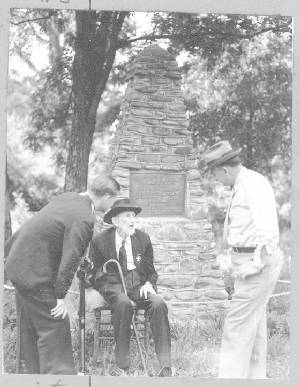
Photograph is Courtesy North Carolina
Office of Archives & History: Department of Cultural Resources
Sulphur Springs
Rd., near 5th St., Waynesville, N.C., on October
9, 1923.
Waynesville,
North Carolina
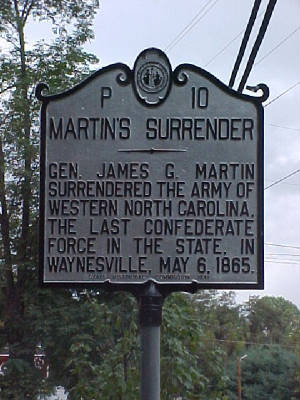
Thomas' Legion surrounded and captured the Union occupied city,
White Sulphur Springs (present-day Waynesville), North Carolina, on May 6, 1865. Ironically,
General Martin and Colonel Thomas also agreed to surrender; they formally surrendered on May
9, 1865. Martin and Thomas understood that on April 9, 1865, General Robert E. Lee had surrendered the Army of Northern Virginia. However, Captain Stephen Whitaker and Company "E" First Battalion (a.k.a. Walker's Battalion) of Thomas' Legion were stationed at nearby Franklin. General Davis Tillson had ordered Colonel George W. Kirk and the Union's 3rd North Carolina Mounted Infantry Regiment to Franklin (O.R., 1, Vol. 49, pt. II, p. 689), and when they approached the battalion, Whitaker formed a skirmish line. Consequently, he received word of Thomas and Martin surrendering at Waynesville, and then
Whitaker and Company E also surrendered.
Final Surrender Memorial: Franklin, North Carolina
Captain Stephen Whitaker surrendering the final Confederate soldiers to Colonel George W. Kirk.
Photographed by the Writer
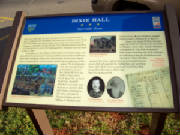
Final Surrender Memorial: Franklin, North Carolina
Captain Stephen Whitaker and Company E, First Battalion (Walker's Battalion), Thomas' Legion parole signatures. Photographed by the Writer
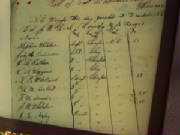
May 12, 1865,
was the "The Final Surrender" for Thomas' Legion. The First Battalion's Company E soldiers signed the parole papers beginning on May 12, with the last signature recorded on May 14, 1865 (Thomas had surrendered on May 9, 1865). Captain Stephen Whitaker and Company E, First Battalion of Thomas' Legion were stationed at nearby Franklin, North Carolina. Whitaker and Company E had recently Skirmished at Hanging Dog, Cherokee County,
and were advancing toward White Sulphur Springs to reinforce Thomas when they were intercepted. When Union Colonel George W. Kirk and the Union's 3rd North Carolina Mounted Infantry Regiment approached the battalion, Captain Whitaker formed a skirmish line. He soon received word of Thomas and Martin surrendering at Waynesville, and then Whitaker and
his company also surrendered. On May 14, 1865, the Legion's soldiers finished signing the
paroles and they viewed Whitaker roll them up, tie them, place them in a Haversack, and give them to Col. Kirk's
Courier. "And thus at 10 o'clock in the morning of May 14, 1865, our Civil War Soldier Life ended and our Every Day Working
Life began," said John H. Stewart of the Thomas Legion. The Confederates surrendered
to Colonel Kirk understanding that additional
fighting was futile and senseless, and, finally, the aftermath embraced the region.
Notes:
The Union Army recruited two mounted infantry regiments within North Carolina, and both mounted regiments were raised principally from Western North Carolina counties: William C. Bartlett
commanded the Union 2nd North Carolina Mounted Infantry Regiment, and George W. Kirk commanded the Union 3rd North Carolina
Mounted Infantry Regiment. Recruitment of these regiments epitomized the "Brother's War" and the men serving in the two Union
mounted infantry regiments were commonly referred to as "Home Yankees." Approximately 10,000 white North Carolinians served the United States during the war, while more than 5,000 North Carolina African Americans joined the Union Army. These free blacks and escaped slaves served in segregated regiments led by white officers.
Union Major General
George Stoneman's command as it concerns Western North Carolina in 1865: Second North Carolina Mounted Infantry Regiment,
Lieut. Colonel William C. Bartlett; Third North Carolina Mounted Infantry Regiment, Colonel George W. Kirk; First Brigade,
Commanding Colonel Chauncey G. Hawley; Fourth Division, Department of the Cumberland, Brig. General Davis Tillson; District
of East Tennessee, Major General George Stoneman (to view entire Union District of East Tennessee, including 1st and 2nd Brigades,
and Brig. Gen. A. C. Gillem's Cavalry Division, please see O.R., 1, 49, pt. II, pp. 538-539)
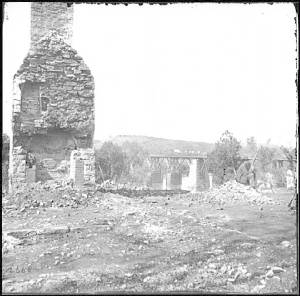
Photograph is Courtesy Library of Congress
The 1,600-foot Strawberry Plains Bridge spanned the Holston River and was located approximately
15 miles from Knoxville. It was considered the most important bridge in East Tennessee, and it was destroyed and rebuilt several times during the Civil War. When destroyed, United States Military
Academy graduate and Union General, Ambrose Burnside, pleasurably stated, “It will take months to rebuild it.”
O.R., 23, i, 385.
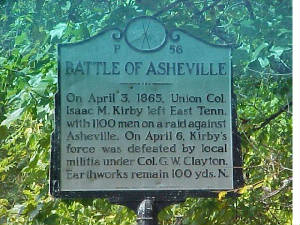
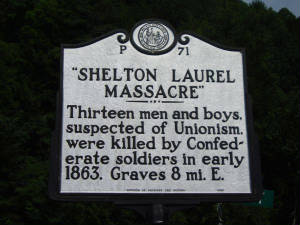
Photograph is Courtesy North Carolina
Office of Archives & History: Department of Cultural Resources
White Sulphur Springs Memorial
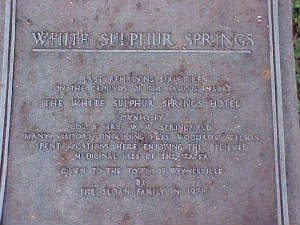
In 1971 the Sloan family donated
the land where the renowned White Sulphur Springs Hotel once stood. The Sloans are descendants of Lt. Colonel William W. Stringfield.
Eastern Cherokee Tribal Council Members in 1891
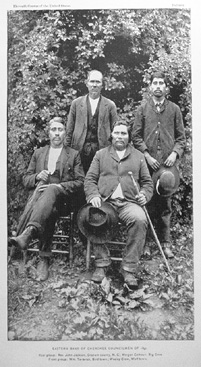
Rev. John Jackson, Morgan Calhoun, Wm.Ta-la-lah, and Wesley Crow
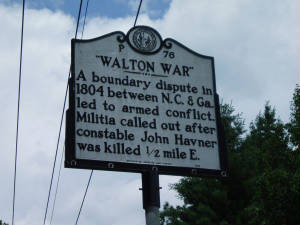
Tennessee State Flag and its Origin
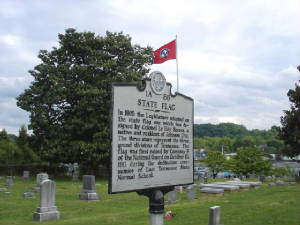
The Thomas Legion fought numerous skirmishes and battles in Tennessee. Divided loyalties in the region had
no boundaries and, during the aftermath, spawned feuds which would last for decades. Madame Collier was a federal soldier from East Tennessee who enjoyed army life until her capture and subsequent imprisonment at Belle Isle, Virginia. She decided
to make the most of the difficult situation and continued concealing her gender, hoping for exchange. Another prisoner learned
her secret and reported it to Confederate authorities, who sent her North under a flag of truce. John L. Ransom, Andersonville Diary (1881), pp. 20-21
Editor's Pick: Co.
Aytch: A Confederate Memoir of the Civil War. Description: Of the 120 men who enlisted in "Company H"
(Or Co. Aytch as he calls it) in 1861, Sam Watkins was one of only seven alive when General Joseph E. Johnston's Army of Tennessee
surrendered to General William Tecumseh Sherman in North Carolina
in April, 1865. Of the 1,200 men who fought in the First Tennessee, only 65 were left to be paroled on that day. "Co. Aytch: A Confederate Memoir of the Civil War" is heralded by many historians as one of the best
war memoirs written by a common soldier of the field. Sam R. Watkin's writing style in "Co Aytch" is quite engaging and skillfully
captures the pride, misery, glory, and horror experienced by the common foot soldier. Continued below…
About the Author: Samuel "Sam"
Rush Watkins (June 26, 1839 - July 20, 1901) was a noted Confederate soldier during the American Civil War. He is known today
for his memoir Company Aytch: Or, a Side Show of the Big Show, often heralded as one of the best primary sources about the
common soldier's Civil War experience. Watkins was born on June 26, 1839 near Columbia, Maury County, Tennessee, and received his formal education at Jackson
College in Columbia.
He originally enlisted in the "Bigby Greys" of the 3rd Tennessee Infantry in Mount Pleasant, Tennessee, but transferred shortly
thereafter to the First Tennessee Infantry, Company H (the "Maury Greys") in the spring of 1861. Watkins faithfully served
throughout the duration of the War, participating in the battles of Shiloh, Corinth, Perryville,
Murfreesboro (Stones River),
Shelbyville, Chattanooga, Chickamauga, Missionary Ridge, Resaca,
Adairsville, Kennesaw Mountain (Cheatham
Hill), New Hope Church, Zion
Church, Kingston, Cassville, Atlanta,
Jonesboro, Franklin, and Nashville.
Of the 120 men who enlisted in "Company H" in 1861, Sam Watkins was one of only seven alive when General Joseph E. Johnston's
Army of Tennessee surrendered to General William Tecumseh Sherman in North Carolina
April, 1865. Of the 1,200 men who fought in the First Tennessee, only 65 were left to be paroled on that day. Soon after the
war ended, Watkins began writing his memoir, entitled "Company Aytch: Or, a Side Show of the Big Show". It was originally
serialized in the Columbia, Tennessee
Herald newspaper. "Co. Aytch" was published in a first edition of 2,000 in book form in 1882. "Co. Aytch" is heralded by many
historians as one of the best war memoirs written by a common soldier of the field. Sam's writing style is quite engaging
and skillfully captures the pride, misery, glory, and horror experienced by the common foot soldier. Watkins is often featured
and quoted in Ken Burns' 1990 documentary titled The Civil War. Watkins died on July 20, 1901 at the age of sixty-two in his
home in the Ashwood Community. He was buried with full military honors by the members of the Leonidas Polk Bivouac, United
Confederate Veterans, in the cemetery of the Zion Presbyterian Church near Mount
Pleasant, Tennessee.
Related Pictures and Reading:
Recommended Reading: Storm
in the Mountains: Thomas' Confederate Legion of Cherokee Indians and Mountaineers (Thomas' Legion: The Sixty-ninth North Carolina Regiment). Description: Vernon H.
Crow, Storm in the Mountains, spent 10 years conducting extensive Thomas
Legion's research. Crow was granted access to rare manuscripts, special collections, and privately held diaries
which add great depth to this rarely discussed Civil War legion. He explores and discusses the unit's formation, fighting
history, and life of the legion's commander--Confederate Colonel and Cherokee chief--William Holland Thomas. Continued below...
Numerous maps and photographs allow the reader to better understand and
relate to the subjects discussed. It also contains rosters which is an added bonus for researchers and genealogists. Crow,
furthermore, left no stone unturned while examining the many facets of the Thomas Legion and his research is conveyed on a
level that scores with Civil War students and scholars alike.
Recommended
Reading: Rebel Private: Front and Rear: Memoirs of a Confederate Soldier. Description: First published in 1907, the memoirs of a former Confederate soldier
who fought at Gettysburg, Chancellorsville, Second Manassas, and Chickamauga reveal the ground-level perspective of a Civil War private. Continued below…
From
Publishers Weekly: William Fletcher joined
the Confederate Army in 1861. He served with the Army of Northern Virginia's elite Texas Brigade until the Battle of Chickamauga.
Unable to march because of wounds, he transferred to the cavalry and finished the war with the Texas Rangers, then wrote his
memoirs 40 years later. Most of the original copies were destroyed in a fire. The current edition presents unvarnished images
of hard marches, short rations and battles in which being wounded could prove worse than being killed. Fletcher describes
the horrors of being a Civil War casualty as vividly as any firsthand account from either side. The author emerges from these
pages as fighting less for a cause than for his own pride in being a good soldier. His narrative does more than many learned
monographs to explain the Confederacy's long endurance against overwhelming odds.
Recommended Viewing: The American Civil War (DVD Megaset) (2009) (A&E Television
Networks-The History Channel) (14 DVDs) (1697 minutes) (28 Hours 17 Minutes + extras). Experience for yourself the historical
and personal impact of the Civil War in a way that only HISTORY can present in this moving megaset™, filled with
over 28 hours of American Civil War content. This MEGASET is the most comprehensive
American Civil War compilation to date and is the mother of all Civil War documentaries. A
multifaceted look at “The War Between the States,” this definitive collection brings the most legendary Civil
War battles, and the soldiers and leaders who fought them, vividly to life. From Gettysburg and Antietam to Shiloh, and led
by the likes of Sherman, McClellan, Grant, Beauregard, Lee, Davis, and Jackson, delve into the full military and political
contexts of these men, their armies, and the clashes between them. Continued below...
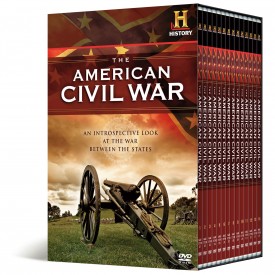
Almost 150 years after Lee’s surrender at Appomattox Court House,
the unexpected secrets and little-known stories from Civil War history are divulged with fascinating detail. Cutting-edge
CGI and accurate dramatizations illustrate archival letters and original diary entries, and the country’s most renowned
historians describe the less familiar incidents that add perspective and depth to the war that divided a nation. If the DVDs
in this Megaset were purchased separately, it could cost hundreds of dollars. This one-of-a-kind compilation belongs on the
shelf of every Civil War buff, and if you know anyone that is interested in the most costliest and bloodiest war in American
history, buy this, they will love it.
THE AMERICAN CIVIL WAR contains the following programs:
* The Most Daring Mission Of The Civil War
* April 1865
* Battlefield
Detectives: The Civil War (3 Episodes): Antietam, Gettysburg, Shiloh
* Secret Missions Of The Civil War
* The Lost Battle
Of The Civil War
* Tales Of The Gun: Guns Of The Civil War
* Eighty Acres Of Hell
* Lincoln
* Investigating History:
Lincoln: Man Or Myth
* Man, Moment, Machine: Lincoln & The Flying, Spying Machine
* Conspiracy?: Lincoln Assassination
*
High Tech Lincoln
* Sherman’s March
* The Hunt For John Wilkes Booth
* Civil War Combat (4 Episodes): The Hornets’
Nest At Shiloh, The Bloody Lane At Antietam, The Wheatfield At Gettysburg, The Tragedy At Cold Harbor
* Civil War Journal
(8 Episodes): John Brown's War, Destiny At Fort Sumter, The Battle of 1st Bull Run, The 54th Massachusetts, West Point Classmates—Civil
War Enemies, Robert E. Lee, Stonewall Jackson, Sherman And The March To The Sea
BONUS FEATURES:
* Full-Length Documentary “Save Our History: Sherman’s Total
War Tactics”
* Behind the Scenes Featurettes for “Sherman’s March” and “Lincoln”
|

